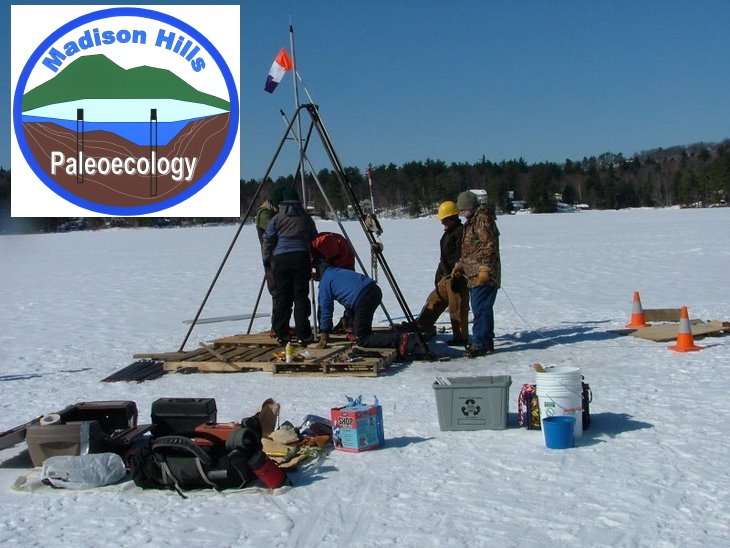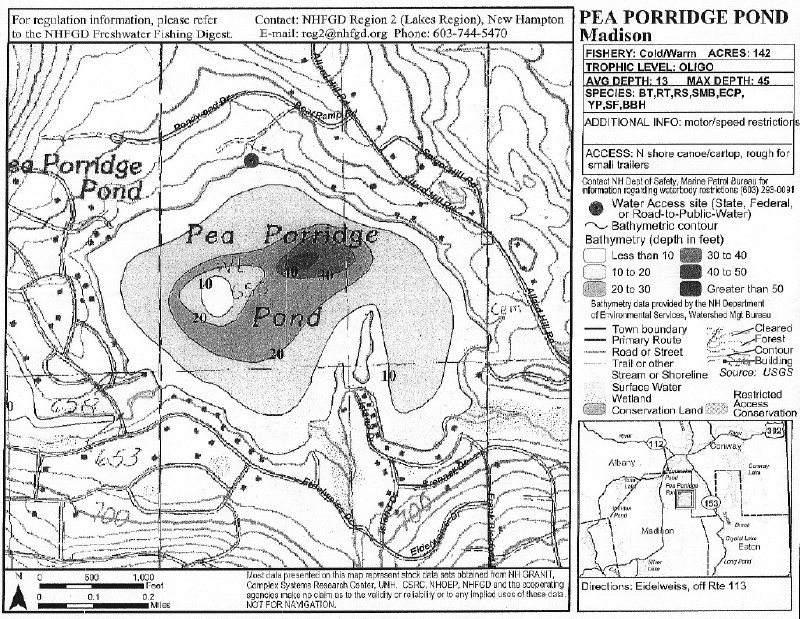Earlier, we posted results from winter and spring water column surveys of temperature and dissolved oxygen (a posting from April 4, 2008 and Scientific Posting Numbers 15 respectively). Accompanying those results are discussions of how this information can help us understand the circulation and productivity of Big Pea Porridge Pond.
This posting continues the sequence by adding temperature and oxygen profiles from summer (August 3, 2008), when the temperature stratification or layering of the water column is maximal. The warmed top layer or epilimnion of the lake shows temperature in the 23-25 C range (73.4-77 F) extending some 4 meters (13 ft) into the water column. The deep waters of the lake, i.e., the hypolimnion waters, are in the 7-8 C (44.5-46.5 F) range. The intervening zone, from 4-8 meters depth, in which the temperature falls by at least 1 degree/meter, is the metalimnion or thermocline.
Larger, "first class" lakes hold all of the summer-added heat in surface waters, leaving the deep hypolimnion waters constant at 4 C (39.2 F) year-round. The hypolimnion depths in smaller lakes like Big Pea Porridge Pond incorporate some "excess" surface heat defining our lake as a "second class" lake (an unfortunate term with ABSOLUTELY NO bearing on its importance to us!).
Oxygen enters freshwater lakes in one of three ways: imported -- via diffusion from the surrounding atmosphere or as dissolved oxygen in inlet streams, or in-situ -- as a by-product of photosynthesis (6 CO2 + 6 H20 → C6H12O6 (glucose) + 6 O2). The August 4th oxygen profile (circles) provides interesting results. A curve of this sort, with the oxygen maximum in the metalimnion (thermocline) is known as a "positive heterograde oxygen curve". Large, cold water inlet streams could theoretically bring higher levels of oxygen in as a colder, denser water mass at such depths. But there are no such inlet streams entering Big Pea Porridge Pond. The only other logical source for high levels of oxygen 6 meters down in the metalimnion would be productivity by single-celled or colonial phytoplankton located there. Because high light levels (including damaging UV light) found in surface waters are actually inhibitory to most phytoplankton, maximal photosynthetic activity by phytoplankton is usually found somewhat deeper. But a deep positive heterograde peak like that seen here in early August results from dominance by cold-adapted phytoplankton that do best in waters away from the sun-heated epilimnion. Often less-desirable blue-green photosynthetic bacteria such as the filamentous Oscillatoria are responsible for such curves. (Blue-greens are less desirable because they tend to produce chemical byproducts that other organisms find toxic). We need to follow up with a deep plankton tow to determine what phytoplankters are found at depth here in our pond.
Observed dissolved oxygen readings can be compared to the line in the figure with triangle symbols that represents what would have been saturation levels of dissolved oxygen based on the actual temperature reading alone (recall the inverse relationship between temperature and the solubility of all gases -- meaning that the higher the temperature, the less dissolved oxygen would be available). The supersaturation levels within the metalimnion are clear. But also note that observed dissolved oxygen falls short of saturation levels toward the bottom. Typically, loss of dissolved oxygen in deep waters results from oxygen consumption by the bacterial and fungal decomposers found in bottom sediments. The degree of their activity, and thus the degree of oxygen consumption through their respiration, is a reflection of the amount of organic (biologically produced) matter available. Little productivity (oligotrophy) would result in little decomposer activity and little oxygen depletion below saturation levels. High productivity (eutrophy) would provide enough organic fall-out to fuel extensive decomposer action and a steep depletion of deep oxygen perhaps even to producing anaerobic (oxygen-free) conditions. Our situation matches what we observed in our March profiles – about one half the available oxygen has been consumed, suggesting a mesotrophic condition in Big Pea Porridge Pond. .. Lee



